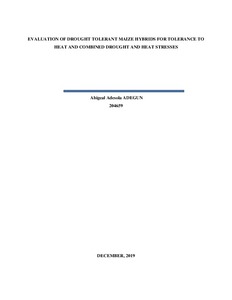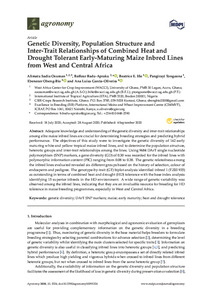| dc.contributor.author | Adebayo, A. |
| dc.contributor.author | Menkir, A. |
| dc.contributor.author | Blay, E. |
| dc.contributor.author | Gracen, V.E. |
| dc.contributor.author | Danquah, E.Y. |
| dc.date.accessioned | 2019-12-04T11:03:32Z |
| dc.date.available | 2019-12-04T11:03:32Z |
| dc.date.issued | 2014 |
| dc.identifier.citation | Adebayo, A., Menkir, A., Blay, E., Gracen, V. & Danquaha, E. (2014). Performance-based grouping of adapted and exotic drought-tolerant maize (Zea mays L) inbred lines under stressed and non-stressed conditions. Maydica, 59(2), 115-123. |
| dc.identifier.issn | 0025-6153 |
| dc.identifier.uri | https://hdl.handle.net/20.500.12478/1131 |
| dc.description.abstract | Knowledge of the heterotic responses of elite adapted and exotic maize inbred lines can facilitate their utilization for population improvement and hybrid development. In the present study, a line x tester mating design was used to determine the combining ability of 20 elite drought-tolerant maize inbred lines developed at CIMMYT and IITA and to classify them into heterotic groups under diverse growing conditions. The 20 lines were crossed each with two inbred line testers representing the tropical and temperate heterotic pattern established in West and Cental Africa (WCA), to generate 40 testcrosses. A trial comprising the 40 testcrosses along with the cross between the two testers and three hybrid checks were evaluated at two environments in the dry season and at six environments in the rainy season. GCA effects were more important than SCA effects in controlling grain yield in both seasons. Two exotic lines in the dry season and four exotic lines in the rainy season had significantly positive GCA effects. Only EXL22 was identified as a superior line in the two seasons. Only two adapted lines had significantly positive GCA effects in either or both seasons while three adapted lines consistently had significantly negative GCA effects in both seasons. Hybrid between EXL22 and tester 9071 showed broad adaptation to all test environments. The two testers separated some of the lines into two main heterotic groups. the lines in each heterotic group and the good combiners will be utilized for developing populations for extracting new improved inbred lines. |
| dc.language.iso | en |
| dc.subject | Maize |
| dc.subject | Combining Ability |
| dc.subject | Germplasm |
| dc.subject | Drought Tolerance
Maize |
| dc.subject | Combining Ability |
| dc.subject | Germplasm |
| dc.subject | Drought Tolerance
Maize |
| dc.subject | Combining Ability |
| dc.subject | Germplasm |
| dc.subject | Drought Tolerance
Maize |
| dc.subject | Combining Ability |
| dc.subject | Germplasm |
| dc.subject | Drought Tolerance
Maize |
| dc.subject | Combining Ability |
| dc.subject | Germplasm |
| dc.subject | Drought Tolerance
Maize |
| dc.subject | Combining Ability |
| dc.subject | Germplasm |
| dc.subject | Drought Tolerance |
| dc.title | Performance based grouping of adapted and exotic drought tolerant maize (Zea mays L) inbred lines under stressed and nonstressed conditions |
| dc.type | Journal Article |
| dc.description.version | Peer Review |
| cg.contributor.affiliation | University of Ghana |
| cg.contributor.affiliation | International Institute of Tropical Agriculture |
| cg.contributor.affiliation | Ladoke Akintola University of Technology |
| cg.coverage.region | Africa |
| cg.coverage.region | West Africa |
| cg.coverage.country | Nigeria |
| cg.isijournal | ISI Journal |
| cg.authorship.types | CGIAR and developing country institute |
| cg.iitasubject | Maize |
| cg.journal | Maydica |
| cg.howpublished | Formally Published |
| cg.accessibilitystatus | Open Access |
| local.dspaceid | 78129 |




